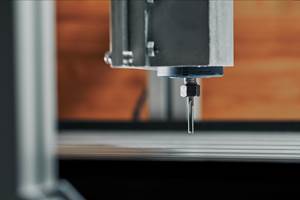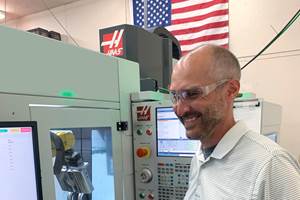CAM Software Improves Speed-To-Market For Job Shop
As technology progressed, this shop's CAD/CAM software became outdated, and the company needed a more advanced system. The owner wanted a system that anyone in the company could feel confident using without extensive training.
Future Fabricators (Phoenix, Arizona) specializes in precision machining work. The majority of the machining performed at Future Fabricators is 2.5D type work such as milling, drilling and boring. In addition to machining components for the aerospace, pipeline and semiconductor industries, Future Fabricators has developed a niche in manufacturing the components used in fuel control and hydraulic/pneumatic systems.
As technology progressed, Future Fabricators' CAD/CAM software became outdated, and the company needed a more advanced system. Owner Ray Rubin wanted a system that anyone in the company could feel confident using without extensive training. On the other hand, he needed software that could handle jobs ranging from simple 2.5-axis milling and drilling to the more complex work of machining surfaces and castings with compound angles. The software also had to have good design capabilities for the custom test fixtures the company designs and builds.
Mr. Rubin selected FeatureCAM software from Engineering Geometry Systems (Salt Lake City, Utah). To match the different complexities of the parts the company machines, Mr. Rubin purchased three seats of FeatureCAM, each with different modules to provide a variety of complex modeling and machining capabilities. Having three seats is useful when a part requires minor modifications or NC code needs to be reposted. A shop lead can make a change without interrupting one of the full-time programmers.
Mr. Rubin purchased FeatureMill2.5D and FeatureTurn/Mill. The company uses FeatureMill2.5D to create 3D geometry and features or import part files from customers and apply 2.5-axis to four-axis machining operations. For turning and turn/mill operations, FeatureTurn/Mill combines efficient turning operations with the same milling functionality as FeatureMill2.5D.
To meet its design and surfacing needs, the company purchased FeatureMill3D with FeatureRecognition. This module is used to automatically recognize all the holes and drafted and non-drafted milling surfaces on imported solid models, so the programmer doesn't have to manually select or define those features.
Since purchasing FeatureCAM, the time it takes a new CNC programmer to become productive has been reduced dramatically. In training costs alone, the software has produced savings in time and money.
Another cost savings is the quick turnaround from the time a drawing or CAD file is received to the time a program is sent to the shop floor. Most of the time, customers send regular blueprints or 2D CAD files with their orders. "Doing a 2D design, working from a blueprint, goes very quickly," says Mr. Rubin. "Programming 2.5D parts is a snap."
To run FeatureCAM on any networked PC, a network module was also purchased. Although the network module can be placed on a dedicated Windows NT server, Donsco uses one of the regular PC workstations to serve out the network licenses.
The software's user interface is designed to free CNC programmers from routine tasks so they can use their expertise choosing the best machining strategies. Programming 2.5D parts in FeatureCAM is fast, because machining properties are associated with features, such as pockets or holes, as they are created. It only takes a few mouse clicks to create a hole feature and define the drilling operations.
As the programmer creates features, FeatureCAM eliminates many steps by using knowledge-based technology to determine rough and finishing operations for each feature, select the correct tools for each operation, calculate feeds and speeds, and generate toolpaths. For instance, programmers can use the system to analyze every hole feature on a part to determine the shortest toolpath and perform all the spot drills first.
Because machining properties are associated with each feature, it's fast and easy to try different machining strategies and simulate the results while generating the G-code in a preview window. The operations list, tool list and NC code are all visible on the screen.
The programmers have found it easy to customize posts from within FeatureCAM and see the results immediately. The programmer clicks a button to display the post options dialog box, selects the post to customize and then edits the parameters. FeatureCAM organizes the post parameters in drop-down menus and dialog boxes, so guesswork is eliminated. When the NC code is re-posted, the changes are immediately visible.
It's just as easy to customize manufacturing parameters, tool libraries and feed and speed tables. Customized manufacturing parameters are saved in unique configuration files, so preferred machining attributes, such as step-over and lead-in and lead-out moves, can be saved and used for similar types of parts.
The principles of lean manufacturing have been adopted throughout the company with the goal of eliminating waste at all levels. For Future Fabricators, FeatureCAM promotes this lean philosophy by reducing the time required to draw and program parts, by capturing user-specific information and best machining strategies, and by generating G-code that doesn't need hand manipulation. Reduced programming time has thus increased speed-to-market.
Related Content
Five Safety Considerations for CNC Machinists
Safety in CNC environments is essential for users – and for productivity. Consider these 5 points to avoid injury, part failure and downtime.
Read More6 Machine Shop Essentials to Stay Competitive
If you want to streamline production and be competitive in the industry, you will need far more than a standard three-axis CNC mill or two-axis CNC lathe and a few measuring tools.
Read More5 G-Code Tips for Increasing CNC Efficiency
Optimizing G code is a low-cost way to improve CNC efficiency without sacrificing usability and safety.
Read More5 Reasons Why Machine Shop Ownership Is Changing
Mergers, acquisitions and other ownership changes are an effect of Boomer-age shop owners retiring, but only in part. Also important: The way we think about machining has changed.
Read MoreRead Next
3 Mistakes That Cause CNC Programs to Fail
Despite enhancements to manufacturing technology, there are still issues today that can cause programs to fail. These failures can cause lost time, scrapped parts, damaged machines and even injured operators.
Read MoreThe Cut Scene: The Finer Details of Large-Format Machining
Small details and features can have an outsized impact on large parts, such as Barbco’s collapsible utility drill head.
Read More



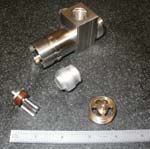
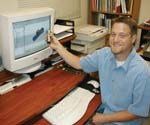
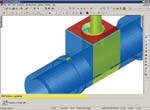










.png;maxWidth=300;quality=90)




